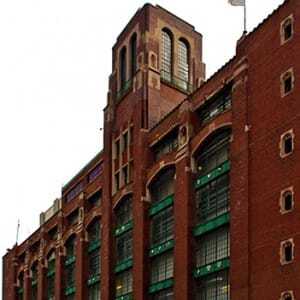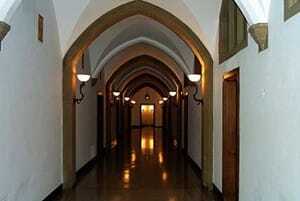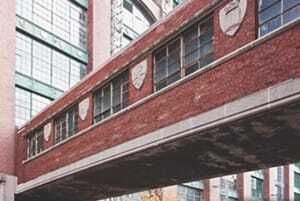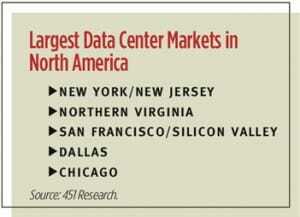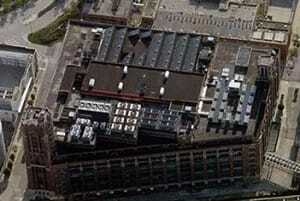Resources that drove the industrial economy—a central location and access to power—plus old factories just waiting to be put to use, give Chicago an edge in the data center business.
As we log on with greater frequency to buy a shirt, stream a video, pay a bill, or even make high-speed stock trades, the information highway seems to grow more and more complex. Yet when it comes to the actual real estate supporting it, the digital route looks a lot like the roads, and railways, of decades past. Along public ways such as expressways and railroad tracks are plenty of outdated warehouses where cargo was once loaded and unloaded. Near those brawny buildings now lie vast networks of underground fiber-optic cables that make today’s digital economy go.
In Chicago, whose central location has long made it a distribution and manufacturing hub, some once-gritty industrial stretches are returning to relevance. Obsolete manufacturing plants are finding a second life as data centers that plug into those fiber networks.
As it turns out, data centers require many of the same features traditionally found in factories: access to massive amounts of electric power, thick brick-and-concrete structures, floors capable of handling heavy loads, and high ceilings. Older industrial buildings also tend to have few windows—a bonus for both security and cooling purposes. And, not least, manufacturing areas tend to cluster along the major roads and railways along which fiber-optic cable was laid.
As it turns out, data centers require many of the same features traditionally found in factories: access to massive amounts of electric power, thick brick-and-concrete structures, floors capable of handling heavy loads, and high ceilings. Older industrial buildings also tend to have few windows—a bonus for both security and cooling purposes. And, not least, manufacturing areas tend to cluster along the major roads and railways along which fiber-optic cable was laid.
“People think of the internet and the cloud as this magic thing that rains down from the skies, but it’s totally physical,” says John Tolva, the city of Chicago’s chief technology officer. “You need the facilities.”
Public/Private PartnersTolva is involved in the Data Center Express program, the city’s partnership with power company Commonwealth Edison and World Business Chicago, the city’s economic development arm. It was created to identify buildings that are ideal for future data centers, as well as to streamline the process for developers seeking access to sources of electricity, water, and fiber-optic cables. Data Center Express also provides a single point of contact to help expedite unique requests, such as the need to bore through a tunnel, that unexpectedly arise when old buildings are being retrofitted for new-world purposes.
Geography is a selling point in more ways than one. Despite the potential for tornadoes in its suburbs, the Chicago area has an overall risk of natural disasters that is low relative to most parts of the country. That is an important distinction after severe weather events that hit the East Coast in recent years, which have led some corporations to reevaluate having all of their data storage concentrated in the same geographic area.which already has 29 active data centers in the city alone, according to Tolva. Some of the world’s largest data centers are in the Chicago area, in part because its proximity to vast fiber capacity provides low latency, or lag time, which is vital in financial markets and other businesses where miniscule fractions of a second are all-important. “We’re going to take all the advantages we have, which are mostly [related to] being central,” he says. “Nationally, all of the internet backbone goes through our city. More internet volume passes through Chicago than any other city.”
“After Hurricane Sandy, Chicago is going to become more dominant in the financial markets,” says Avner Papouchado, president of Server Farm Realty, which is developing one of the largest data centers in Chicago. “We had the 100-year storm three years in a row on the Eastern Seaboard. People don’t like having all of their data subject to a single event.” Sandy’s long-term effect on data center site selection remains unclear, says Tolva, but he notes: “It certainly has changed the conversation about the importance of out-of-region redundancy.”
Winter weather may be a drawback for Chicago tourism, but cold air pulled in from outside can be used as a low-cost means to chill water that is used to prevent equipment from overheating. Chicago data center boosters also point to energy costs that run lower than in many competing markets such as the New York/New Jersey metro area.
Although data centers are not large employers, they are seen by the city as drivers of economic activity. The benefits of connectivity are reaped by more than just the private sector that drives it. One example is the I-WIRE fiber network. Using existing infrastructure throughout the Chicago area, I-WIRE interconnects research computers at Argonne National Laboratory, the University of Illinois at Urbana-Champaign, the University of Illinois at Chicago, the University of Chicago, Northwestern University, and the Illinois Institute of Technology.
“Building a 400,000-square-foot [37,000 sq m] data center is probably the equivalent of building a 2.5 or 3 million-square-foot [232,000 or 279,000 sq m] office tower downtown. It’s very complex. It’s that front-end investment that makes it so hard to survive in this business.”—Glenn Benoist
Supply and Demand
The nation’s largest data center, in terms of total building size, is Digital Realty Trust’s 1.1 million-square-foot (102,000 sq m) Lakeside Technology Center in Chicago’s south Loop, says Chad Freese, a co-leader of real estate brokerage CBRE’s national data center practice. Also among the largest in the United States is DuPont Fabros Technology’s 485,000-square-foot (45,000 sq m) CH1 in west suburban Elk Grove Village, he says. When they are built out, Microsoft’s 707,000-square-foot (66,000 sq m) facility in west suburban Northlake, Server Farm’s 450,000-square-foot (42,000 sq m) south Loop building, and Digital Realty’s 700,000-square-foot (65,000 sq m) Digital Chicago complex in west suburban Franklin Park also will have significant national stature, he says.
Chicago is the fifth-largest data center market in North America, estimated to have nearly 1.96 million square feet (182,000 sq m) of operational space used directly for data storage in its 63 area data centers, according to estimates last compiled in December 2012 by 451 Research. New York/New Jersey, northern Virginia, San Francisco/Silicon Valley, and Dallas are larger, according to 451 Research. The firm’s research projects demand outgrowing new supply through 2014 in Chicago.
“Chicago’s exceptionally strong financial services sector really helps drive data center growth,” says Rick Kurtzbein, a 451 Research analyst. “It may be lagging New York and northern Virginia, but there has been talk about temporary oversupply on the East Coast. I haven’t heard anything about oversupply in Chicago or Dallas. I really see Chicago as healthy and growing. Utilization continues to go up. We’re looking at utilization around 90 percent, which will drive future expansions.” Freese agrees, adding: “We’re not oversupplied by any stretch. I would suggest that Chicago has the least amount of speculatively built space of any of the major markets.”
Digital Realty’s Lakeside Technology Center, a gothic building on East Cermak Road near the hulking McCormick Place convention center, is the kind of success story that demonstrates why a developer would want to enter this unique niche of real estate. In 2005, Digital Realty bought the eight-story former R.R. Donnelly & Sons printing plant, which was built in the early 20th century and converted into a data center by another developer in the 1990s. The northern California real estate investment trust (REIT) spent $400 million, including the $142.6 million acquisition, modernizing the facility, according to Glenn Benoist, a vice president at Digital Realty who oversees the REIT’s central U.S. portfolio. It was 98.5 percent leased and was generating annualized rents of $68.98 million in the first quarter of this year, according to a Securities and Exchange Commission filing. More than 600 trading and financial markets companies use the facility, according to Data Center Express.
Despite the huge upside demonstrated there, many developers are better off steering clear of data centers, which require specialized, high-tech knowledge that most developers aren’t exposed to, Benoist says. “These things aren’t cheap,” he says. “Building a 400,000-square-foot [37,000 sq m] data center is probably the equivalent of building a 2.5 or 3 million-square-foot [232,000 or 279,000 sq m] office tower downtown. It’s very complex. It’s that front-end investment that makes it so hard to survive in this business.”
Hundreds of millions of dollars can be spent before any return is generated years later—a scenario that is not for skittish investors, Tolva notes. “The biggest pitfall is you’ve got to have a huge risk tolerance and a lot of capital,” he says. “They’re hugely capital-intensive. But the payoff is big, and there’s no doubt the cloud is growing.” Most would-be developers, in fact, never even get out of the starting gate. “They’re really expensive mistakes, so lenders don’t play with people who lack the pedigree of developing this stuff and leasing it successfully,” Freese says. “The barriers to entry are extremely high.”
Southeast of Digital Realty’s brick behemoth, Server Farm is investing more than $220 million on a 450,000-square-foot (42,000 sq m) former General Electric motor plant on South Canal Street between the Chicago River and the Dan Ryan Expressway. Server Farm bought it for $35 million in 2011 from Northern Trust. The financial services company had used one of the seven floors for its own data center, while using the rest for information technology workers and other staff.
Server Farm opened the 40-megawatt facility to anchor tenant Peerless Network early this year. Work continues on the existing structure, and plans eventually call for up to 1 million square feet (93,000 sq m) of new construction there, Papouchado says. Using an ideal building such as this one cuts costs, but the approach takes patience and creativity, he says. So far, no magic formula has emerged.
“We’ve developed millions of square feet, and truthfully it’s almost impossible to duplicate from one location to another,” Papouchado says. “Cooling is different; the way electricity is coming in is different; the shape of the buildings is different. Each building, especially when it’s adaptive use, wants to be its own building.”
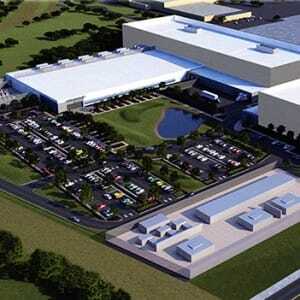
Digital Realty Trust is in the early phases of its Digital Chicago redevelopment, where it is converting a former Motorola television assembly plant into a data center, shown here as a rendering, in west suburban Franklin Park near O’Hare International Airport. When finished, it is expected to be one of the largest digital data storage complexes in the Chicago area. (Digital Realty Trust)
Digital Realty, which in addition to Lakeside Technology Center owns a smaller data center in the south Loop, is in the early phases of redeveloping a west suburban plant where Motorola produced early models of color television sets. More recently, the 22-acre (8.9 ha) property in Franklin Park was used as a 575,000-square-foot (53,000 sq m) office and distribution complex by Frain Group, a seller of used packaging and processing machinery. Digital Realty bought the property near O’Hare International Airport from Frain Group for $22.3 million in 2012. With continued strong demand, Digital Realty could inject more than $400 million into a four-phase, 700,000-square-foot (65,000 sq m) complex, which would include some new construction, Benoist says.
Adaptive UseFirst, Digital Realty will do as much as possible with existing structures, Benoist says. That trend has some environmental implications, in keeping with the saying that the greenest building is the one that already exists. For developers, repurposing a sturdy existing structure also can mean extra green in the bank. “I’m kind of a miser,” Benoist says. “I like to use what’s existing when it has good bones.”
With that in mind, landlords pitch new uses for outdated real estate, sometimes from unexpected places. One conversion candidate on the radar screen of data center developers is a former Chicago Sun-Times newspaper printing plant on the South Side, according to real estate sources. Meanwhile, Sears Holdings has created a wholly owned subsidiary, Ubiquity Critical Environments, to convert some of its closed or underperforming department stores into data centers. The 127-year-old retailer, once a dominant force via mail-order and in-store sales, has begun identifying Sears and Kmart stores that have the right location and infrastructure to support data storage. The first one it pegged for conversion is a Sears store visible from the Chicago Skyway toll road on the South Side, which closed in July.
Because data centers have such unique requirements, developers view them through a different lens than most real estate deals. “The adage in traditional real estate is: location, location, location,” Benoist says. “In data centers, it’s power, connectivity, location.”
Eventually, when the most suitable buildings are snapped up, data centers will be constructed from the ground up. “If you have a good, old building and you buy it at the right [cost] basis, it’s a beautiful thing,” Papouchado says. “The problem is there are so few buildings that have the bones—the right construction, the right load per foot on the floors, the right ceiling heights, and all the right infrastructure. To build these from the ground up is very expensive, but we’re going to get to the point where you can no longer find existing buildings that will work.”

